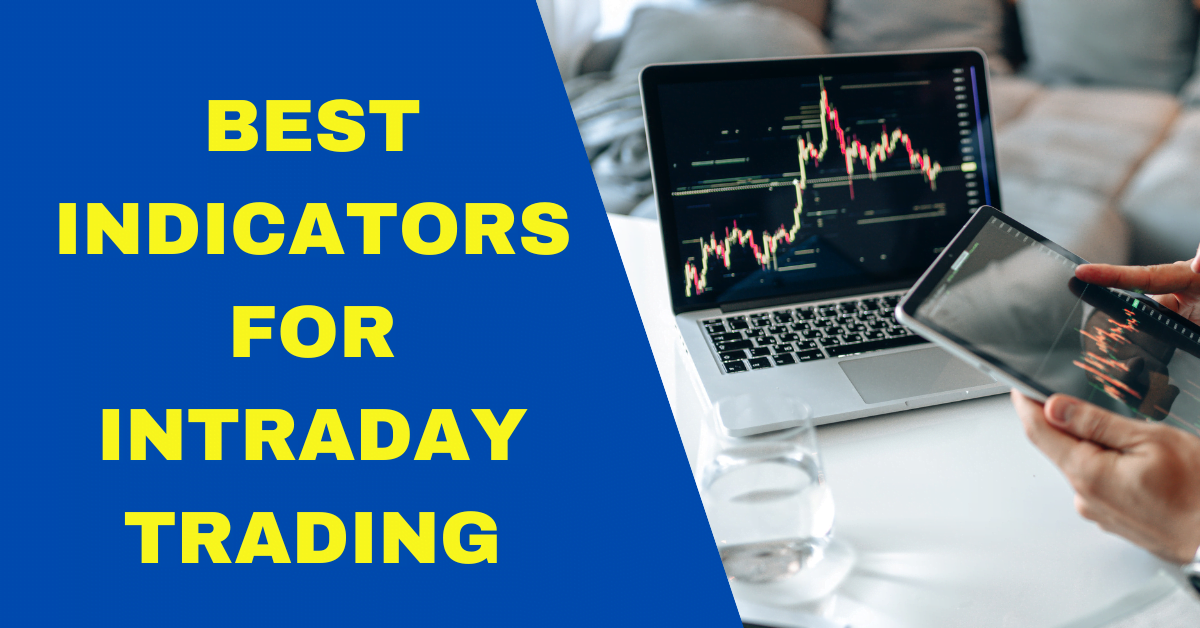Intraday trading, often referred to as day trading, is a dynamic and fast-paced trading style that involves capitalizing on short-term market fluctuations. Successful intraday traders rely on a variety of key indicators to make informed decisions and execute trades effectively. In this comprehensive guide, we will delve into the world of intraday trading indicators and explore which indicators are best for intraday trading..
Intraday trading is a trading style that involves buying and selling financial instruments within the same trading day. It’s characterized by rapid decision-making, short holding periods, and the need for quick analysis. To navigate this fast-paced environment, traders rely on a set of indicators that provide insights into price trends, momentum shifts, liquidity, and breakout potential.
Understanding Intraday Trading Indicators
Moving Averages: Spotting Trends and Reversals
Moving averages are foundational indicators in intraday trading. They smooth out price data over a specified period, making it easier to identify trends and potential reversals. A crossover between short-term and long-term moving averages often signals a change in trend direction. For instance, the intersection of a 50-period moving average with a 200-period moving average can be indicative of a significant market shift
RSI (Relative Strength Index) and Stochastic Oscillator: Gauging Momentum
RSI and the Stochastic Oscillator are momentum indicators that help traders assess the strength and speed of price movements. RSI, measured on a scale from 0 to 100, indicates overbought or oversold conditions. Values above 70 suggest overbought levels, potentially leading to a reversal, while values below 30 indicate oversold levels, possibly signaling a price increase. The Stochastic Oscillator, on the other hand, compares a security’s closing price to its price range over a specific time frame. It consists of two lines, %K and %D, which help identify potential turning points in the market
Volume
Volume is a crucial indicator in intraday trading, providing insights into market liquidity and participation. Higher trading volumes often accompany significant price movements, indicating strong trader interest. Traders analyze volume alongside price data to confirm the strength of a trend or identify potential reversals. A sudden surge in volume can indicate the start of a new trend, while decreasing volume may suggest a weakening trend
Bollinger Bands: Identifying Breakout Opportunities
Bollinger Bands consist of a central moving average and two standard deviation bands. These bands expand and contract based on market volatility. When the price moves close to the upper band, it might indicate an overbought condition, while approaching the lower band may suggest an oversold condition. Bollinger Bands are particularly useful for identifying potential breakout opportunities. A sharp price movement beyond the bands can signal the start of a new trend or a significant price movement
The Power of Indicator Fusion
Intraday traders often find that combining multiple indicators provides a more comprehensive view of market conditions. By fusing indicators that analyze different aspects of price movement, momentum, and volatility, traders can make more informed trading decisions.
Incorporating Intraday Indicators for Market Insight
Trends: Guiding Buying and Selling
Trends are the cornerstone of technical analysis in intraday trading. Identifying the prevailing trend direction helps traders determine whether to buy or sell a security. Moving averages, as discussed earlier, play a vital role in spotting trends. By analyzing the relationship between short-term and long-term moving averages, traders can gain insights into the strength and direction of a trend.
Momentum: Flagging Potential Reversals
Momentum indicators like RSI and the Stochastic Oscillator are essential for detecting potential reversals. Rapid price movements often lead to overbought or oversold conditions, indicating that a price correction may be imminent. Traders can use these indicators to anticipate changes in momentum and adjust their trading strategies accordingly.
Liquidity: Gauging Volume
Volume is a powerful tool for assessing the liquidity of a security. High trading volumes confirm the validity of a price movement, while low volumes can signal potential reversals or periods of consolidation. Traders should analyze volume alongside other indicators to validate the strength of a trend and make more accurate predictions.
Volatility: Signaling Breakout Potential
Bollinger Bands are a valuable indicator for identifying periods of heightened volatility and potential breakouts. A squeeze in the bands, where they converge, often precedes a significant price movement. Traders can use this indicator to anticipate potential breakout points and adjust their strategies accordingly.
Crafting an Effective Intraday Trading Strategy
The Role of Risk Management
Intraday trading is inherently risky, and risk management is paramount to a trader’s success. No single indicator can guarantee profits, which is why traders must implement effective risk management strategies. This includes setting stop-loss and take-profit levels, diversifying their portfolio, and sizing positions appropriately.
The Multi-Indicator Approach
While each indicator provides valuable insights, the true power lies in combining multiple indicators to confirm signals and filter out false alarms. By using a diverse set of indicators, traders can increase their confidence in their trading decisions and reduce the impact of market noise.
Adapting to Market Conditions
Market conditions can change rapidly, and intraday traders must be adaptable. Indicators that work well in trending markets might not perform as effectively during periods of consolidation. Traders should be prepared to adjust their indicator settings or switch between indicators based on the prevailing market conditions.
Professional Strategies and Insights
Experienced intraday traders often employ a combination of indicators, along with market sentiment and fundamental analysis, to refine their trading strategies. professional trading platform
Moving Averages, RSI, MACD, and Volume Indicators
Moving averages, RSI, MACD, and volume indicators are commonly used by professionals to make informed trading decisions. These indicators provide insights into trends, momentum, and market participation, helping traders identify potential entry and exit points.
Fibonacci Retracements and Market Sentiment
In addition to technical indicators, traders also consider Fibonacci retracements and market sentiment. Fibonacci retracement levels indicate potential support and resistance levels based on historical price movements. Market sentiment, which reflects the overall attitude of traders toward security, can influence intraday price movements.
Diversifying Indicators for Reliable Trends
To increase the reliability of trend analysis, traders diversify their indicator toolkit. Moving averages, trendlines, and the ADX (Average Directional Index) are popular choices for identifying and confirming trends. By using a combination of indicators, traders can reduce the likelihood of false signals and make more accurate predictions.
FAQ
What is intraday trading?
Intraday trading, also known as day trading, involves buying and selling financial instruments within the same trading day. Traders aim to capitalize on short-term price movements.
Which indicators are best for intraday trading?
Key indicators for intraday trading include moving averages, RSI, stochastic oscillator, Bollinger Bands, and volume. These indicators help analyze trends, momentum, liquidity, and breakout potential.
How do moving averages work in intraday trading?
Moving averages smooth out price data over a specific period, making it easier to identify trends and potential reversals. Crossovers between short-term and long-term moving averages can signal trend changes.
What is the Relative Strength Index (RSI)?
RSI is a momentum indicator that measures the speed and change of price movements. It ranges from 0 to 100 and helps identify overbought and oversold conditions.
How does the Stochastic Oscillator work?
The Stochastic Oscillator compares a security’s closing price to its price range over a specified time frame. It consists of %K and %D lines, aiding in the detection of potential turning points
Why is volume important in intraday trading?
Volume reflects market liquidity and participation. High volumes confirm strong price movements, while low volumes can suggest reversals or consolidation.
What are Bollinger Bands used for?
Bollinger Bands consist of a moving average and two standard deviation bands. They help identify potential breakout opportunities and periods of heightened volatility.
How can I incorporate multiple indicators effectively?
The fusion of indicators provides a comprehensive view of market conditions. Combining indicators that analyze trends, momentum, and volatility can lead to more informed trading decisions
What role does risk management play in intraday trading?
Risk management is crucial in intraday trading to mitigate potential losses. Traders should set stop-loss and take-profit levels, diversify their portfolio, and size positions appropriately.
How can I adapt my strategy to changing market conditions?
Market conditions can vary, so traders should be prepared to adjust indicator settings or switch between indicators based on the current market environment.
What is the significance of Fibonacci retracements in intraday trading?
Fibonacci retracements indicate potential support and resistance levels based on historical price movements, helping traders identify potential reversal points.
What is market sentiment, and how does it influence intraday trading?
Market sentiment reflects traders’ overall attitude toward security. Positive or negative sentiment can influence intraday price movements.
Is past performance a reliable indicator of future results in intraday trading?
No, past performance is not a guarantee of future outcomes. Traders should approach intraday trading with continuous learning and a disciplined approach to risk management.
Can indicators guarantee profits in intraday trading?
Indicators provide insights, but no indicator can guarantee profits. Successful intraday trading requires a combination of indicators, analysis, risk management, and ongoing education.
How can traders manage the risks associated with intraday trading?
Traders can manage risks by implementing effective risk management strategies, diversifying their trading portfolio, and staying informed about market conditions.
Are there any professional strategies for intraday trading?
Professionals often use a combination of indicators such as moving averages, RSI, MACD, and volume indicators. They also consider Fibonacci retracements, market sentiment, and fundamental analysis.
What is the role of the ADX indicator in identifying trends?
The Average Directional Index (ADX) helps identify the strength of a trend. A rising ADX value suggests a strong trend, while a falling value indicates a weakening trend.
Why is diversifying indicators important for reliable trend analysis?
Diversifying indicators helps reduce the likelihood of false signals. Combining indicators like moving averages, trendlines, and ADX can provide a more accurate picture of market trends.
How should beginners approach intraday trading?
Beginners should start with a solid understanding of basic trading concepts, focus on education, practice with virtual accounts, and gradually transition to real trading with a well-defined strategy.
What should traders keep in mind while trading intraday?
Traders should remember that trading involves risks, and there are no guarantees of profits. It’s essential to approach intraday trading with a disciplined mindset, continuous learning, and effective risk management strategies.
Which platform provides best indicators for intraday trading ?
Trading view provides best indicators for intraday trading
Conclusion: Navigating Market Risks and Embracing Learning
Intraday trading offers opportunities for profit, but it also comes with significant risks. It’s important for traders to recognize that past performance is not indicative of future results. Losses can occur, and successful intraday trading requires continuous learning, adaptability, and a disciplined approach to risk management.
Remember, while indicators provide valuable insights, they should be used as part of a holistic trading strategy. Traders should consider a combination of indicators, market analysis, risk management, and ongoing education to enhance their chances of success in the challenging world of intraday trading.
Disclaimer
Trading involves inherent risks, and there are no guarantees of profits. Losses can exceed investments. Always conduct thorough research and consider seeking advice from financial professionals before making trading decisions.

